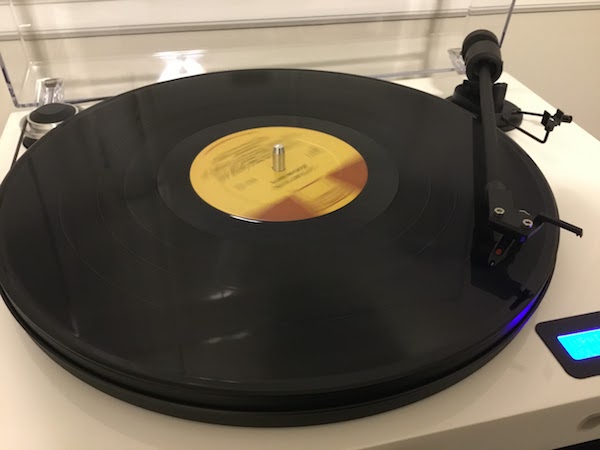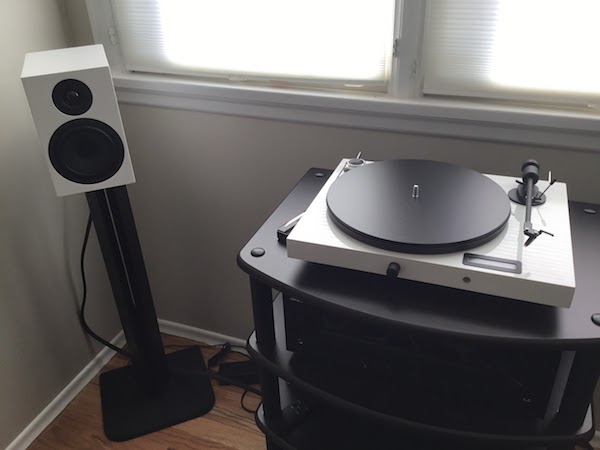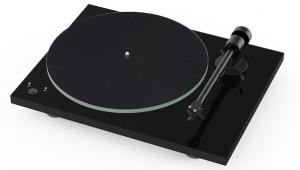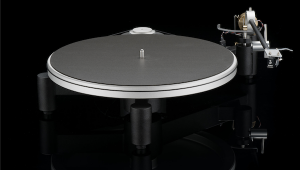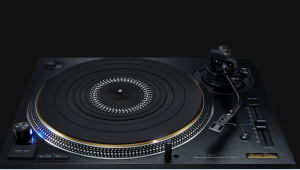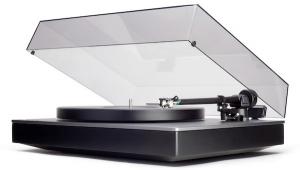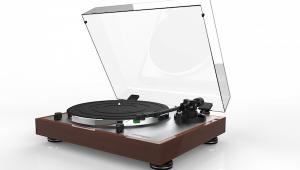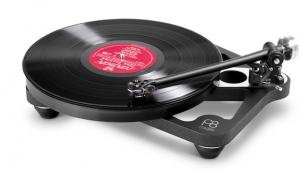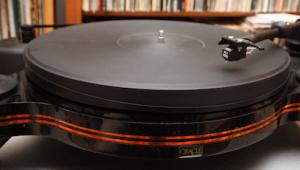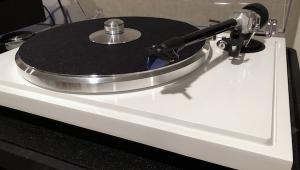Pro-Ject’s New “Juke Box E” System Is A Decent Entry Into Analog (Manufacturer's Response Added)
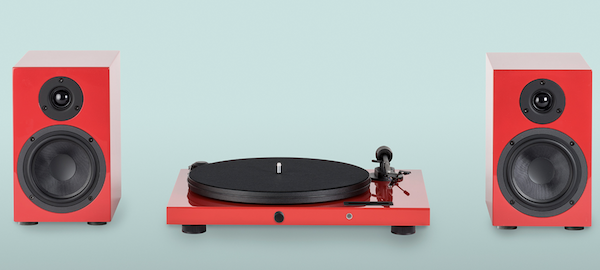
In an attempt to solve that problem, Pro-Ject has introduced the $499 Juke Box E turntable. While it’s over seven times more expensive than the aforementioned record ruiner, it includes 50 watts per channel of built-in amplification and will take good care of your records. It also features an aluminum drive pulley, bass and treble adjustment, remote control, a front 32-step volume knob, a screen that displays source and volume information, synchronous motor, and gold-plated phono and line RCA output jacks, as well as RCA line input jacks and a dust cover. Packed with a pre-mounted Ortofon OM5E cartridge, within minutes of its arrival, a turntable novice will have the Jukebox E spinning tunes. The 300mm MDF removable platter is already inserted into the plinth and the non-adjustable counterweight comes pre-installed, leaving the belt as the only thing to install.
Due to the built-in integrated amp, the Juke Box’s plinth (also MDF) is heavy, but that’s an advantage; it’s extremely resistant to vibrations when placed on a good surface. Got a kid who dances to the music? No problem. A dog that’s jumping on windows and barking at the mailman? Totally fine. The four isolation feet that the turntable sits on reduce vibrations to a point where even a minor earthquake won’t cause the stylus to jump. At 12.5 x 16.25 x 2.25 inches (without included dust cover, 5 inch height with cover), it’s small enough to fit in a small room yet give full stereo separation when hooked up to properly placed speakers. For those who highly value appearance in addition to sound and convenience, the turntable also comes in red, white, and black, all with a high gloss finish.

Along with its strengths in a busy environment, the turntable performs well for the price tag. The sound is good enough to give a high-end audio newbie the analog “bug,” and has many good features. Ortofon’s OM5E cartridge, which itself retails for $70, tracks very well at under 2 grams and has an easily replaceable elliptical (hence the “E”) stylus assembly. The built-in integrated amp sounds a tad bit on the bright side, but not to the point where by any means it sounds harsh. Arguably, the weakest link of the Juke Box E is the 8.6” low-mass aluminum tonearm. Though it incorporates high quality sapphire bearings, for $499 it feels low-end. While the OM5E works well with it, the tonearm wires feel flimsy and Pro-Ject visibly stuffed foam into the arm. This detracts from the turntable’s otherwise slick design.
As far as speed goes, this thing is pretty accurate. When playing a 3150Hz tone from Analogue Productions’ Ultimate Analogue Test LP (AAPT 1), the PlatterSpeed app shows the mean frequency as 3145.9Hz.
There is an RCA input that works well for a CD player or other line level source, but the Bluetooth receiver is problematic. An apparent and constant flutter sound appears due to the wireless connection, though that’s not the biggest problem. All music that is transmitted to the Juke Box through this connection sounds so bad that in comparison it makes my iPad speaker sound like a sonic spectacular. A Bose Bluetooth speaker fares better overall. I played a song from Tidal through the Bluetooth connection before playing the same song on a CD through the RCA line in. The CD sounded superior to the point that it makes me question why Pro-Ject chose to include a Bluetooth receiver. They know it doesn’t sound good at all, and while it’s convenient, there are better ways to hook up a mobile device. Maybe my sample was defective, but I may never know if that’s the case. A 3.5mm AUX input instead would have the same ease of use yet wouldn’t suffer the same issues. (Although fewer phones feature AUX outputs, sadly.)
Speaker Box 5
In what is billed as the “Juke Box E Hifi Set”, you can obtain a pair of Pro-Ject’s Speaker Box 5 bookshelf speakers (pictured stands not included) for an additional $299. Featuring a 1” silk dome tweeter with neodymium magnet and a 5” fiberglass cone woofer, they are available in three colors (as is the turntable), and perform surprisingly well for the size.
When compared to the Elac Debut B5’s, the Speaker Box doesn’t have as much bass (the Elac’s extend to 46Hz, but the latter only goes down to 55Hz). However, these “disappear” more and sound like they aren’t even in your room. Even when I played “Paint It, Black” in stereo from the DSD-sourced Hot Rocks LP, the speakers vanished and the excessive panning even began to sound natural. In my 15’x7’ room, the soundstage is very wide, even though the room isn’t. Individual instruments aren’t as pronounced as they are on the Elacs, but with its attractive and minimalistic design, the Speaker Box 5 is a decent companion to the Juke Box E.
Conclusion
Overall, this system performs very well, and succeeds at prioritizing the turntable in the setup. While it's a tad bit overpriced (considering that EU outlets sell it for $450 USD), it's great for those who want to get into vinyl but have busy lives, a limited budget, and don’t want to research much. The turntable part could have been better with more potential for upgrade, but as far as making an all-in-one, plug-and-play turntable that’s of high quality and is affordable, Pro-Ject hit a bull’s-eye shot.
(U.S. Importer: Sumiko
Technical Specifications
Power output: 2 x 50 Watts (4 Ohm)
Outputs: Speakers, Line out (fixed),
Phono out)
Inputs: Bluetooth, 1x Line (analogue)
Speed: 33, 45 (manual speed change)
Principle: Belt drive
Speed variance: 33: 0.8% 45: 0.7%
Wow & flutter: 33: 0.29%, 45: 0.27%
Platter: 300 mm MDF with felt mat
Main bearing: Stainless steel in bronze bushing
Tonearm: 8.6” aluminum
Effective arm length: 218.5 mm
Overhang: 22.0 mm
Effective tonearm mass: 8.0 g
Counterweight for mass: 3 - 5.5g (pre-mounted)
Tracking force range: 0 - 25mN (OM5e 18mN pre-adjusted)
Included accessories: Power supply, dust cover, remote control
Power consumption 110W max
Dimensions 415 x 118 x 334mm (WxHxD)
Weight 5 kg net
Pro-Ject CEO Heinz Lichtenegger provides manufacturer’s response to Malachi Lui’s Jukebox E review: (Since English is Mr. Lichtenegger’s second language his response has been edited to correct spelling, syntax and other errors that might detract from the clarity of his response, but otherwise it’s been left as received).
Dear Malachi:
Thank you very much for your in deep review of my product. I agree with most of your description. I especially like your words about the “space free” sound.
Because that's basically what was my Intention: to bring the new generation of music lover to the great experience of stereo and analog. Also, I liked how you positioned your speakers well away from the turntable itself.
Correct speaker positioning allows you to have a virtual 3 d sound. Today people are becoming used to mono sound even though some of these turntables are technically “stereo” but because the speakers are so close together, the result is MONO.
So it’s not only that all these toy turntables with built-in speakers are destroying your records, the most important part, the live music "stage" experience communicated so well by stereo is simply missing!
Also with the Jukebox I want to fight against all the TT/active speaker combinations which are quite popular.
The short phono cable does not allow the speakers to be correctly separated so the result is again MONO (and the turntable is too close to the speaker causing bad feedback distortion).
I know that the product is 7 times more expensive than a toy turntable, but it’s also not comparable both in terms of sound and build quality.
We are proud to say that all of our turntable systems are handmade in Europe, using quality materials and no plastic.
Yet all that we provide for our price of $499 is the same price for a better Bluetooth speaker from one of the named famous company. For that same price from us you get a turntable and amplifier plus phono preamp and Bluetooth!
By the way, we offer a great discount on the package with the speakers (600 Euros for Juke Box and speakers though I don’t yet know the US price) and we include a free set of OFC copper wires with gold-plated banana plugs valued at 50 Euros.
Really the speakers we offer are not really comparable with the ELACs in terms of price. Your description is very good, but considering the prices I believe ours has the perfect price/value for an entry system!
I also want to provide some feedback to some parts of the review which for sure I did not ( nor did you) like so much!
Starting with your comments about the “thin” tonearm. Pro-ject has many, many years of experience building tonearms!
One fact we learned early is that cartridge matching is essential. A super high-end cartridge in a wrong (not a bad arm) will not sound good. That has mostly to do with the arm/cartridge combination’s resonant frequency caused by the compliance of the needle, the weight of the cartridge and the arm’s effective mass.
Actually, the OM 5 was designed in the beginning of the ‘80’s where in Europe then very low mass tonearms were very popular( eg.: Dual, Thorens, etc) versus the high mass designs from Japan.
So all these European arms from that time have ultra-low effective mass, similar to the Elemental arm. And that is why it is designed like that to be a perfect partner to the OM 5. The OM 5 on this arm actuslly sounds better then it does on one of our carbon, or aluminum arms on our more expensive turntables!
Also the cable is indeed flimsy and this is because it is the only way to make the tonearm bearing friction free. So it’s by design, not because it makes it cheaper. By the way we are using the same top quality OFC copper (oxygen free copper) wire as in our high end turntables, and yes, for sure we add the foam to the armtube to get better damping. We think this is all very “high end” thinking for a budget-priced product!
Regarding fixed counterweight and fixed antiskating: again out of our experience 90 percent of the bad sound in a low budget turntable is a mis-aligned cartridge and incorrect tracking force.
We have to assume that the customers who buy these products cannot do a good job properly setting VTA/SRA, VTF (vertical tracking force) and anti-skating, so decided to make the Jukebox pre-adjusted at the factory and strictly “plug and play “. Problem solved!
However, if you have the correct size allen key, a gauge and a test record, you can adjust the arm, but that’s the dealer’s job.
Bluetooth
I understand your disappointment with your unit’s Bluetooth performance and I admit this is a tricky one to explain. Perhaps you received a defective unit. I have asked Sumiko, our U.S. distributor to check your sample upon its return ,but I also think there are some general misunderstandings.
1) Our product is linear. There is no processing and of course as you noted, the speakers are super open sounding. For sure it easly shows you that a CD source directly plugged in is many times better than a Bluetooth wireless connection!
On a heavily equalized, boomy Bluetooth speaker you simply do not hear the differences and so Bluetooth will sound OK.
Therefore we have also added to this product the bass /treble option, which functions only in Bluetooth mode and not phono mode. We feel these options are unnecessary for analog playback.
Also, even if at first the boom Bluetooth speaker sounds better, remember it’s stil mono! So if you do adjust you will hear it can sound much better.
2) You have to be very careful with the volume setting. That has to be carefully adjusted. You will get bad sound A) when you put the Jukebox on 100 volume and try to regulate the volume on your Bluetoothdevice. Any amp with 100 open input tends to distort.
B) When you have your mobile device on max, (“the output is opten depends on the music distorted” (—I was unable to sort out the meaning of this to correct the translation—Ed.) Also, please consider these facts and try to find the right balance (between mobile device output level and Jukebox amplifier output). I am sure you will be better pleased with the result.
Upgrades
We have several upgrade options for the Jukebox E:
:
1) A better Platter of acrylic
2) A better more powerful power supply that also features improved grounding that produces less noise.
3) A better stylus: you can easily change to an OM 10 /20 or 30 stylus for improved performance.
A long, Long Statement!
Sorry, but you know we had 2 years of development time on this product in order to get the best compromise between sound quality, easy to use and compact dimensions and to produce this quality level at a reasonable price and not make it in China.
If you have any question I would be happy to answer you as fast as possible. Again, thank you for your great work.
All the best,
Heinz Lichtenegger, CEO Pro-Ject
Note: EISA awarded the more costly (though not all that different) Jukebox, the Pro-Ject Juke Box S2 its 2018-2019 Analog Music System Award—Ed.
